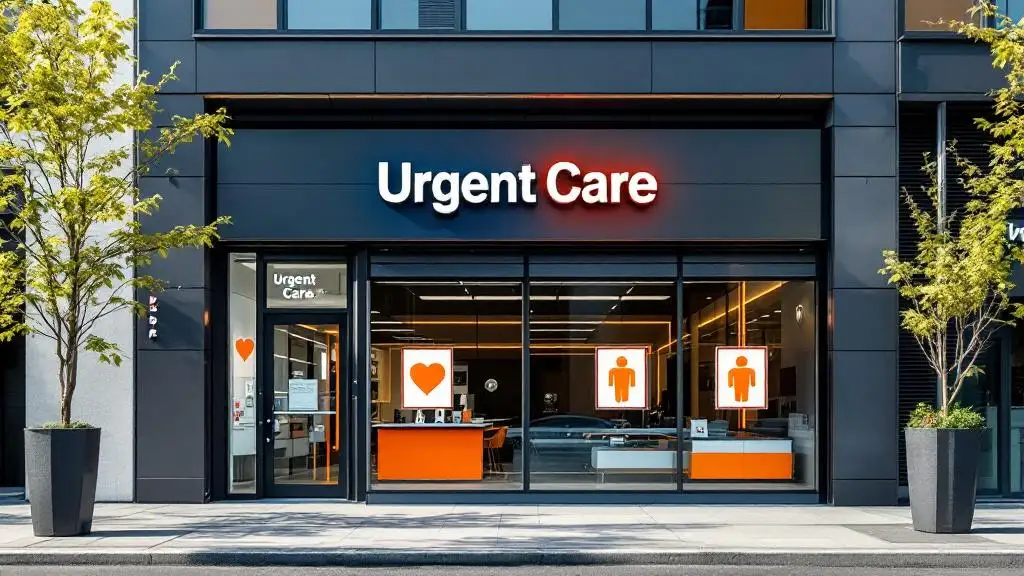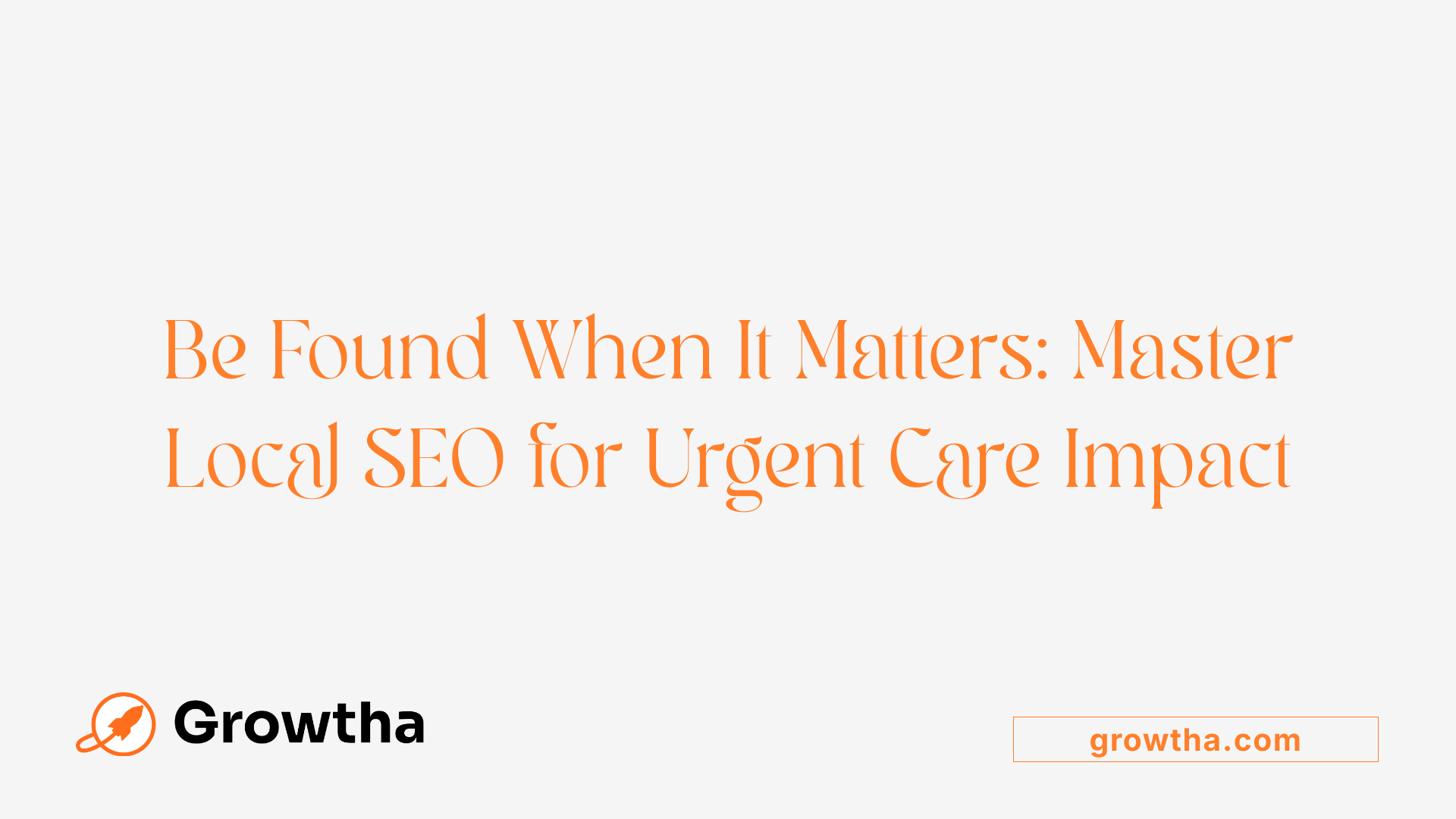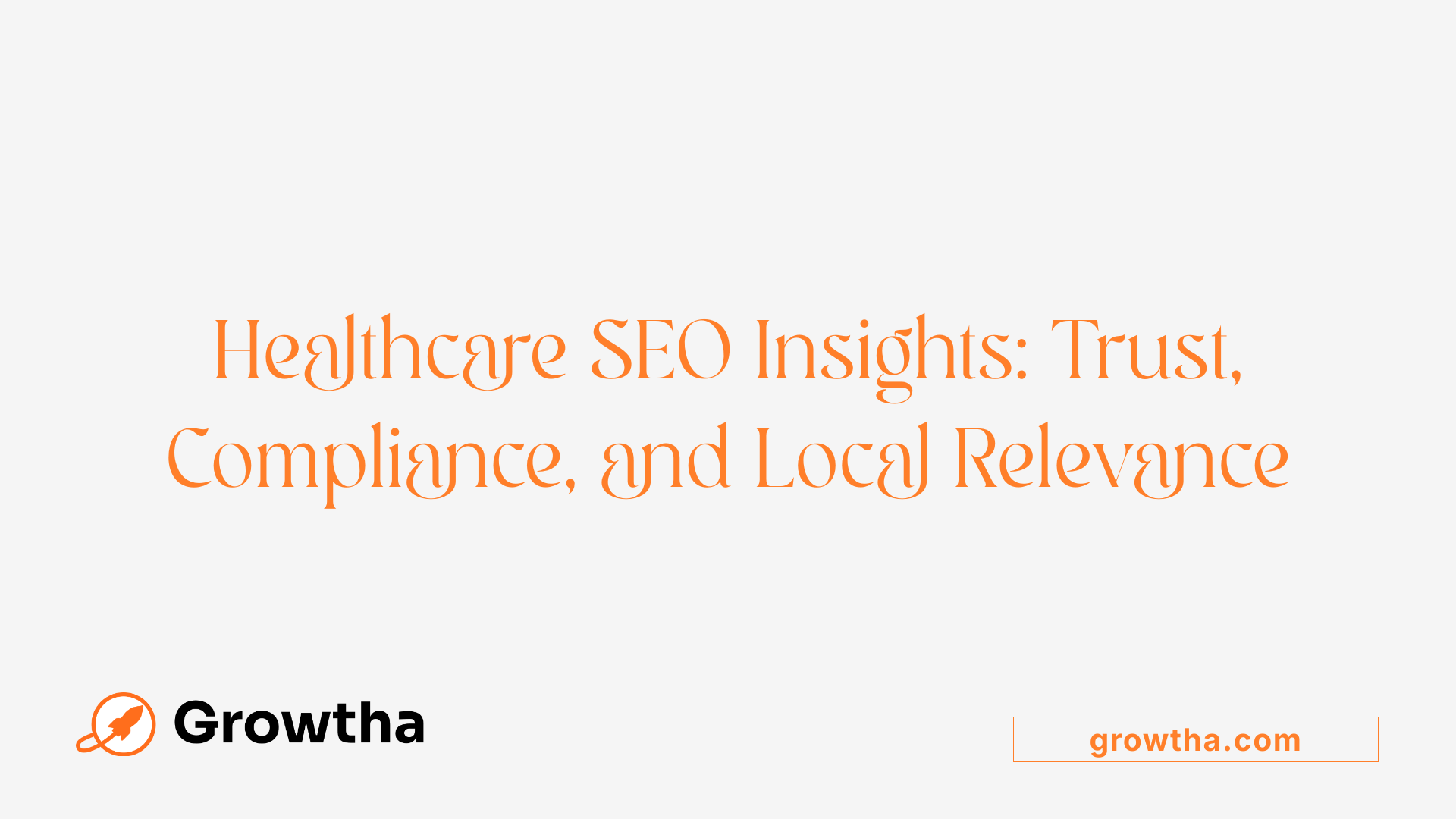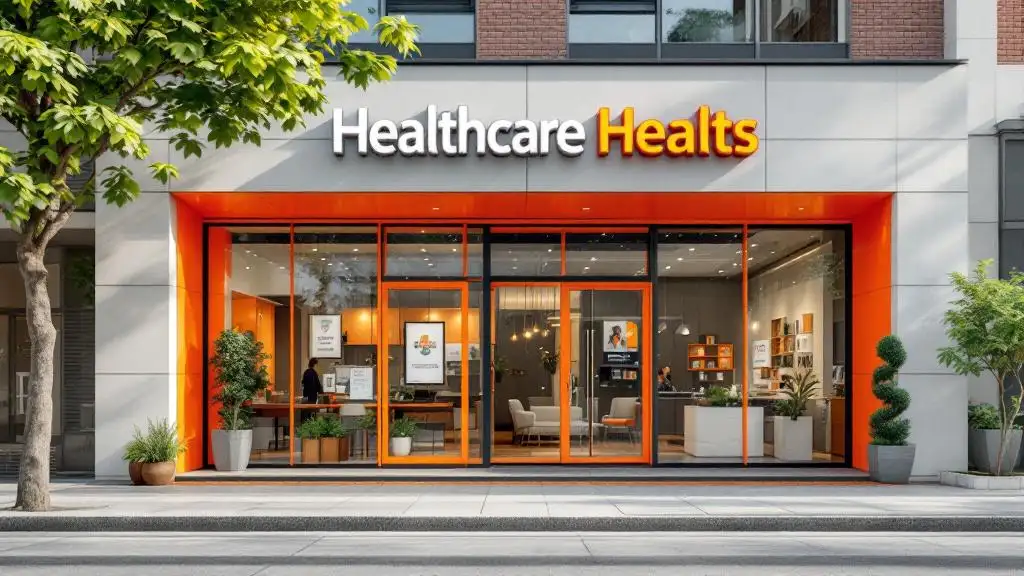SEO Tips for Urgent Care Facilities
Enhancing Visibility: Essential SEO Strategies for Urgent Care Centers


SEO Tips for Urgent Care Facilities
Introduction to SEO for Urgent Care Clinics
In the highly competitive healthcare landscape, especially for urgent care facilities, a robust online presence is essential for attracting new patients and maintaining a steady flow of service. Search Engine Optimization (SEO) plays a pivotal role in ensuring your clinic appears prominently when local patients search for immediate healthcare needs. This article explores effective SEO tips tailored specifically for urgent care centers, covering foundational strategies, local optimization, content development, and practical implementation to maximize your online visibility and patient engagement.
Core SEO Strategies for Urgent Care Facilities
What are the core SEO strategies for urgent care facilities?
Implementing effective SEO is crucial for urgent care clinics aiming to attract local patients and increase visibility in search engines. The foundation begins with thorough keyword research. This involves identifying relevant search terms like "urgent care near me," "walk-in clinic," or specific services such as "stitches" or "fractures." These keywords should be integrated into website content, titles, meta descriptions, and URLs to improve rankings.
Website optimization also plays a vital role. Ensuring your site loads quickly, is mobile-friendly, and features a clear, easy-to-navigate structure enhances user experience and boosts search performance. Incorporating schema markup, especially local business schema, helps search engines understand and display your clinic's details better.
Local search tactics are particularly essential. Managing and optimizing your Google My Business profile—making sure all information is accurate and up to date—can significantly improve your clinic's presence in Google Maps and local pack results. Consistency in NAP data (name, address, phone number) across all online directories like Yelp, Healthgrades, and Zocdoc is equally important.
Creating high-quality, relevant content tailored to local and urgent health concerns helps establish authority. Blog posts addressing topics such as common injuries or illnesses, FAQs about services, and community health initiatives not only provide value but also improve search visibility.
Backlink building is another key element. Earning links from reputable healthcare sites, local news outlets, and professional associations increases your website's authority. Additionally, technical SEO considerations like fixing crawl errors, optimizing website structure, and adding relevant internal links ensure that search engines can index your site effectively and understand your content.
Long-term SEO success involves continuous monitoring and adjusting strategies based on analytics data. Regular analysis with tools like Google Search Console and Google Analytics helps track progress, identify opportunities, and refine approaches.
In summary, comprehensive SEO efforts encompassing keyword research, website optimization, local SEO, valuable content creation, backlink development, and technical fixes form the backbone of a strong digital presence for urgent care clinics.
The Critical Role of Local SEO for Urgent Care Clinics

Why is local SEO important for urgent care clinics?
Local SEO is crucial for urgent care clinics because it helps them appear at the top of local search results, especially when patients are seeking immediate care nearby. When optimized effectively, a clinic's online presence becomes more visible to potential patients searching for urgent or walk-in medical services in their area.
One of the foundational strategies involves optimizing the Google My Business (GMB) profile. This includes ensuring that all information—such as hours of operation, contact details, and services—is accurate and up-to-date. A complete GMB profile with high-quality photos, patient reviews, and timely updates increases trust and visibility.
Consistency across all online citations—platforms like Yelp, Healthgrades, and Zocdoc—is essential. Patients often rely on these listings for accurate information, and discrepancies can lead to confusion or lost opportunities. Regularly reviewing and updating these listings ensures that the clinic maintains a trustworthy reputation.
Creating location-specific pages and content tailored to local health concerns helps improve search rankings and engagement. For example, dedicated pages about treatment options for local communities or common regional health issues can attract targeted organic traffic.
Leveraging local keywords in website content, meta descriptions, and headers—including terms like “urgent care near me”—aligns with what local patients are searching for. Implementing schema markup for local businesses further enhances visibility in local packs.
Encouraging satisfied patients to leave reviews on Google and other directories plays a significant role in building a positive reputation. Responding to reviews demonstrates engagement and care, which search engines and patients value highly.
In addition, optimizing for mobile responsiveness and fast load times is vital because most urgent care searches happen on smartphones. A quick, mobile-friendly website with clear calls-to-action, such as online appointment booking, improves user experience and conversion rates.
Utilizing local backlinks from authoritative sources like community websites and health blogs helps boost domain authority and search rankings. Engaging on social media with geo-tags and local hashtags further enhances community presence and credibility.
Together, these strategies ensure that urgent care centers are easily discoverable at critical moments, turning online searches into patient visits. They also help clinics stand out in a competitive healthcare landscape by establishing trust and authority in local markets.
Improving Online Visibility and Search Engine Rankings

How can urgent care providers improve their online visibility and search engine rankings?
Urgent care clinics can significantly boost their online presence by employing comprehensive SEO strategies focused on local search optimization. A crucial step is claiming and optimizing their Google My Business (GMB) profile. This involves ensuring all information—such as the practice name, address, phone number, operating hours, and services—is accurate and consistently updated across all platforms. Adding high-quality photos, responding to reviews, and posting updates regularly make the GMB profile more attractive to potential patients.
Website optimization for mobile devices is essential. Sites should load quickly, be fully responsive, and incorporate local schema markup to highlight relevant details such as location and services. These technical improvements help websites rank higher in local search results and enhance user experience.
Creating relevant content using local keywords is another effective tactic. Incorporate regional terms into website pages, meta descriptions, headers, and blog posts. Developing region-specific service pages and informative blogs about local health issues can establish authority, attract targeted organic traffic, and improve search rankings.
Building backlinks from reputable healthcare directories, community organizations, and local news websites further enhances domain authority. Engagement with the community via patient reviews and ratings also plays a vital role—encouraging satisfied patients to share positive feedback can improve local search visibility and credibility.
To maintain competitive rankings, clinics should regularly monitor their SEO performance through tools like Google Analytics and Search Console. Updating content, tracking keyword rankings, and refining strategies based on data ensure sustained growth.
Overall, combining local SEO, technical optimization, high-quality content, and active review management can help urgent care providers appear prominently in search results when patients look for nearby urgent care options.
The Role of Content and Optimization Techniques in Enhancing Online Presence
 Creating patient-centric content is vital for boosting an urgent care facility’s online visibility. This includes developing educational materials such as FAQs, health tips, and blog posts that address common medical concerns. These resources should be optimized with relevant keywords and structured with clear headers and compelling meta descriptions to improve search engine ranking.
Creating patient-centric content is vital for boosting an urgent care facility’s online visibility. This includes developing educational materials such as FAQs, health tips, and blog posts that address common medical concerns. These resources should be optimized with relevant keywords and structured with clear headers and compelling meta descriptions to improve search engine ranking.
Visual content like videos and infographics further engage website visitors. For example, videos showcasing facility tours or explaining treatment procedures help build trust and make information more accessible. Infographics illustrating symptoms or prevention tips simplify complex medical data, making it easier for patients to understand.
Implementing schema markup and rich snippets on the website enhances how search engines display information. Features like star ratings, FAQs, or event details in search results can attract more clicks from local searches.
Publishing local health blogs, news updates, and community health events not only improves SEO but also positions the facility as a trusted local health resource. These content pieces should target community-specific keywords and include location-specific information.
Engagement on social media platforms further extends reach. Using geo-tags, local hashtags, and promoting community partnership activities helps foster a local presence. Collaborations with influencers and partnerships with local businesses can increase exposure.
To maximize these efforts, continuously monitor key performance metrics with tools like Google Analytics and Search Console. Adjusting strategies based on analytics insights ensures ongoing growth and improved patient engagement.
Overall, combining high-quality, optimized content with active community engagement and technical SEO techniques creates a robust online presence that attracts and retains local patients.
Understanding Healthcare-Specific SEO Differences

How does healthcare-specific SEO differ from general SEO practices?
Healthcare-specific SEO involves tailored strategies that prioritize compliance with regulations like HIPAA and YMYL (Your Money or Your Life) standards. Unlike broad SEO approaches, it emphasizes building trust through accurate, authoritative content designed to inform and support patients. Such content must be clear, evidence-based, and ethical, reflecting the sensitivity and importance of health information.
A major distinction is the focus on local SEO. Urgent care clinics and healthcare providers heavily rely on local search optimization, especially through detailed Google My Business profiles, local citations, and keywords that target nearby patients. Optimizing for local intent ensures that potential patients find relevant, nearby services quickly.
Technical SEO components are also crucial. Implementing structured data like schema markup enhances how health organizations appear on search results, including rich snippets and maps, which are vital for quick accessibility in urgent situations. Mobile responsiveness and fast load times are non-negotiable, reflecting the mobile-first nature of health-related searches.
Additionally, reputation management takes center stage. Healthcare providers actively encourage positive reviews, respond professionally to feedback, and leverage patient testimonials. This builds credibility and enhances search rankings.
Healthcare SEO also requires a focus on keywords. Careful research is necessary to identify terms with high search volume and clear patient intent, such as “urgent care near me,” “walk-in clinic,” or specific symptoms. Creating content around these keywords positions clinics as trustworthy, accessible sources for urgent health needs.
In essence, healthcare SEO’s unique attributes stem from a need for compliance, trustworthiness, and local relevance. Proper execution ensures that healthcare providers appear prominently when patients seek urgent and general medical care, all while safeguarding patient privacy and adhering to legal standards.
Practical Implementation of SEO Strategies for Urgent Care Providers

How can urgent care providers practically implement SEO strategies?
Urgent care providers can start by optimizing their Google My Business (GMB) profile. This involves updating it with complete and accurate information such as operating hours, contact details, and highlighted services. Regularly posting updates and engaging with patient reviews helps boost local visibility and reputation.
Conducting detailed local keyword research is essential. Focus on terms like 'urgent care near me', 'walk-in clinic', or location-specific keywords that patients commonly search for. Incorporating these keywords naturally into website content, meta descriptions, and service pages significantly improves search engine ranking.
Developing relevant, high-quality content is another vital step. Create informative blog posts addressing common health concerns and topics relevant to your local community. Optimizing this content with targeted keywords helps attract organic traffic and establish authority.
Website technical optimization should not be overlooked. Ensure that your site is mobile-responsive, loads quickly, and is easy to navigate. Use schema markup to provide search engines with detailed information about your services and location, enhancing your chances of appearing in local pack results.
Building local citations on platforms like Yelp, Healthgrades, and Zocdoc ensures consistency across directories, which boosts local SEO. Encourage satisfied patients to leave positive reviews, and manage these reviews actively to build trust.
Lastly, monitor your SEO progress using tools like Google Analytics and Search Console. Regular analysis allows you to refine your strategies, track the impact of your efforts, and maintain or improve your search positions over time.
Implementing these practical steps helps urgent care centers attract more local patients, especially in urgent situations, and enhances their online presence as dependable medical providers.
Summing Up: The Importance of Continuous SEO Efforts
Why is regular monitoring of SEO performance crucial?
Ongoing assessment using tools like Google Analytics, Google Search Console, and Google My Business insights helps healthcare providers track what’s working and identify areas that need improvement. Regularly checking these metrics allows clinics to refine their strategies, stay ahead of local competitors, and respond promptly to changes in user behavior or search trends.
How should content be updated and expanded?
Healthcare information is constantly evolving, making it essential to keep website content current. Regularly adding new blog posts, updating existing pages, and creating educational materials about trending health issues not only improves search rankings but also establishes the practice as a trusted authority. High-quality, relevant content keeps visitors engaged longer and encourages sharing.
How can SEO tactics be adjusted based on insights?
Using data collected from analytics, clinics can identify which keywords are driving traffic, which pages have high bounce rates, and how visitors interact with the site. This information guides strategic adjustments such as optimizing underperforming pages, refining keyword usage, or enhancing user experience. Flexibility in SEO approaches helps maintain a competitive edge.
Why is staying current with industry changes important?
Search engine algorithms evolve frequently, affecting how content is ranked. Staying informed about industry updates allows healthcare providers to adapt their SEO practices accordingly. Participating in industry forums, subscribing to SEO news updates, and following best practice guides help ensure strategies remain effective and compliant.
What role do backlinks and patient reviews play?
Building and maintaining high-quality backlinks from reputable health and medical websites boosts domain authority and search rankings. At the same time, encouraging satisfied patients to leave positive reviews, especially on Google, enhances local search visibility. Responding to reviews demonstrates active reputation management and engagement with the community.
| Key Activities | Impact | Recommendations |
|---|---|---|
| Performance Monitoring | Tracks progress and informs adjustments | Use analytics tools regularly |
| Content Updates | Keeps website relevant and authoritative | Add blogs on recent health trends |
| Strategy Adjustment | Improves search visibility | Refine keywords and optimize pages |
| Industry Trends | Ensures SEO practices stay effective | Follow SEO updates and best practices |
| Backlinks & Reviews | Boosts authority and trust | Outreach for backlinks, encourage reviews |
Optimizing local SEO remains a continuous process. By consistently monitoring, updating, and refining their online presence, urgent care centers can stay prominent in local search results, attract more patients, and maintain a competitive edge.
Closing Thoughts on SEO for Urgent Care Centers
Implementing a comprehensive SEO strategy tailored specifically for urgent care clinics is essential for standing out in a crowded marketplace. From optimizing local listings and fine-tuning website performance to creating valuable content and managing reviews, every facet of SEO contributes to increased visibility, credibility, and patient trust. It’s important to understand that SEO is not a one-time task but an ongoing process that requires regular tracking, updates, and strategic adjustments. By integrating these best practices into your digital marketing efforts, urgent care centers can effectively attract more local patients, enhance their online presence, and secure a competitive edge in the healthcare industry.
References
- Urgent Care SEO - Patient Care Marketing Pros
- Urgent Care SEO for Non-marketers: What, Why, and How - Experity
- SEO for Urgent Care - Haden Interactive
- A Complete Guide to Local SEO for Healthcare Providers! - WillDom
- 7 Best SEO Tips to Elevate Urgent Care Visibility
- SEO for Urgent Care Clinics - How to Drive More Traffic to Your ...
- SEO for Urgent Care Clinics - Funnel Boost Media
- Urgent Care Marketing Ideas: 20 Ways to Attract More Patients







